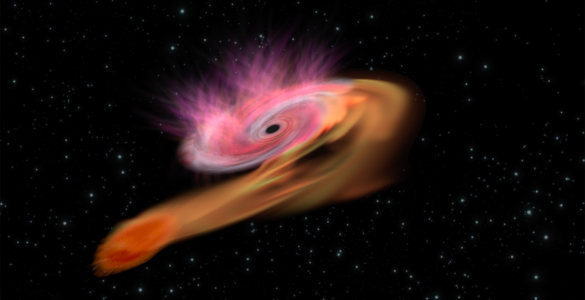The formation of massive stars and planets. The deaths of stars and galaxies. The extreme and violent behaviors of black hole jets and quasars. An up-close and personal radar view of the Moon. These mysteries and more were unraveled in 2021 by radio astronomers leveraging the scientific and technological power of National Radio Astronomy Observatory (NRAO) facilities: the Karl G. Jansky Very Large Array, the Very Long Baseline Array, and the Atacama Large Millimeter/submillimeter Array—an international collaboration with the European Southern Observatory and the National Astronomical Observatory of Japan. Narrated by Phil Plait, NRAO’s top 2021 science highlights explore the awe-provoking wonders of the Universe.
Massive Planet Formation
Astronomers have used the Atacama Large Millimeter/submillimeter Array to study how planets form around young stars. It turns out that large planets form thanks to a bit of chaos.
Writing and narration provided by Phil Plait @SYFY
Discover more about how planets can form from the original press release:
https://public.nrao.edu/news/chaotic-young-star-reveals-planet-formation/
Massive Star Formation
How do some stars get so massive? The Atacama Large Millimeter/submillimeter Array (ALMA) tried to find out by studying an active star-forming region. It turns out the process of large star formation is messier than we thought.
Writing and narration provided by Phil Plait @SYFY
Discover more about how massive stars are born from the original press release:
https://public.nrao.edu/news/massive-young-stars-forming/
Star-Forming in the Milky Way
Where do stars form in the Milky Way? More places than you might think. Recently a project called the Global View on Star Formation in the Milky Way (GLOSTAR) found previously undiscovered regions in our galaxy where large stars are being born.
Writing and narration provided by Phil Plait @SYFY
Discover more about where stars form in the Milky Way from the original press release:
https://public.nrao.edu/news/new-study-star-formation-milky-way/
Galaxies Running Out Of Gas
Some galaxies stop producing stars when they are still young. It turns out they run out of available gas early on. Now astronomers are using a survey called VERTICO – The Virgo Environment Traced in Carbon Monoxide Survey – to find out why.
Writing and narration provided by Phil Plait @SYFY
Discover more about how galaxies run out of gas from the original press release:
https://public.nrao.edu/news/alma-massive-galaxies-running-on-empty/
Compact Object Creates a Supernova
When a star eats a black hole, it can create a massive explosion. Astronomers using the Karl G. Jansky Very Large Array (VLA) have studied radio light from a supernova, which shows it may have been triggered by the last meal of a massive star.
Writing and narration provided by Phil Plait @SYFY
Discover more about what can cause a supernova from the original press release:
https://public.nrao.edu/news/stellar-collision-triggers-supernova/
Quasar Distance Record
Quasars are brilliant objects powered by supermassive black holes. They are often seen at the edge of the observable universe. Early this year the Atacama Large Millimeter/submillimeter Array (ALMA) discovered the most distant quasar ever, powered by a black hole 1.6 billion times more massive than the Sun.
Writing and narration provided by Phil Plait @SYFY
Discover more about this distant quasar from the original press release:
https://public.nrao.edu/news/quasar-new-distance-record/
Helical Jet of M87
When black holes consume matter, they can create powerful jets of ionized material that stream away from the black hole at nearly the speed of light. Using NRAO’s Karl G. Jansky Very Large Array (VLA), astronomers have captured images of one such jet coming from the supermassive black hole in the galaxy M87, revealing a complex helical structure.
Writing and narration provided by Phil Plait @SYFY
Discover more about the jets of M87 from the original press release:
https://public.nrao.edu/news/helix-structure-in-jet/
Planetary Radar
Astronomers study the Universe by capturing light from stars, planets, and galaxies. But they can also study nearby objects by shining radio light on them. It’s a process known as astronomical radar, and it’s revealing fascinating details about our planetary neighbors.
Writing and narration provided by Phil Plait @SYFY
Discover more about astronomical radar from the original press release:
https://public.nrao.edu/news/radar-tycho-crater-intricate-detail/
Media Contacts
Amy C. Oliver
Public Information & News Manager, NRAO
Public Information Officer, ALMA-NA
+1 434 242 9584
aoliver@nrao.edu
Dave Finley
Public Information Officer, VLA
+1 575 835 7302
dfinley@nrao.edu














